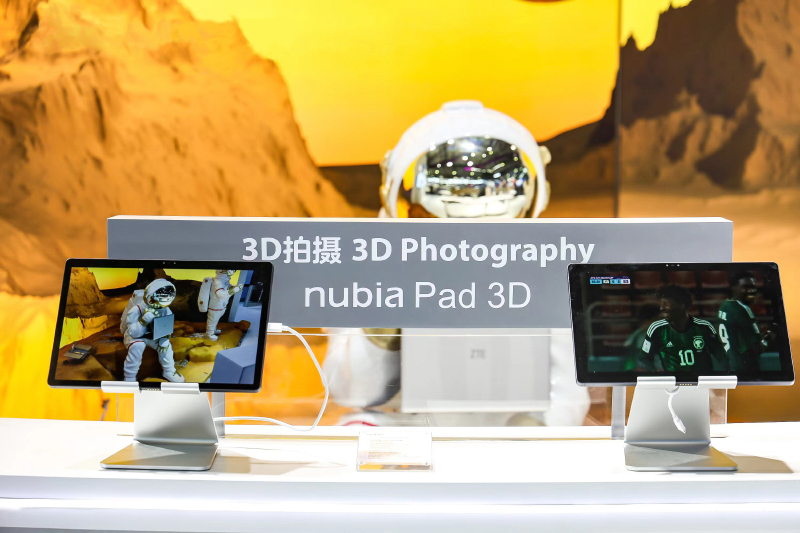
MWC Shanghai 2023 was recently held last week where ZTE showcased their new innovations at the event.
 |
| ZTE's booth |
ZTE's newest technology at MWC Shanghai 2023!
ZTE started by displaying its Terminals business, they provided guests with all-round display and experience by showing smartphones, tablets, smart AR Glasses, MBB and FWA products, and internet products for vehicles and industries. These offerings are equipped with innovative smart AI applications, leading mobile data terminals, and updated smart V2X products.
Meanwhile, the brand also proudly showed its new type of intelligent computing infrastructure. They said it is designed to find a solution for the computing challenges associated with large-scale model computing.
 |
| nubia Neo Air |
ZTE also demonstrated a wide range of devices designed to cover all consumer mobile communication scenarios such as the latest AI-powered eyewear-free 3D tablet and the GPT wireless AR glasses which are one of the highlights inside the booth.
 |
| Neo Air 2 |
You can see the nubia Neo Air, which is the world's first lightweight refractive AR glasses with GPT and wireless functions. ZTE says it allows users to have intelligent interactions like real-time interviews, voice assistants chatting and voice data query through its integrated AI model.
 |
| The Z50 Ultra |
In addition, ZTE shows its flagship 5G tablet known as the AxonPad, the office computer AxonBook and the new flagship 5G smartphones namely the Axon 50 Ultra and Z50 Ultra.
Inside the booth, the company displayed ZTE 5G MBB and FWA products with a leading market share globally for having the most advanced tech in the commercialized field, and GIS (Green, Intelligence, and Security) accomplishments, covering the recent 5th gen of WiFi 7 5G FWA, 5G indoor and outdoor FWA and 5G portable WiFi. By connecting to the internet through wireless networks, these products can support fast and efficient data transfer.
Also, during the event, ZTE displayed the efficiency and convenience of these technologies which are designed for power saving, intelligent scenario control, and network security.
 |
| nubia Pad 3D |
The nubia Pad 3D, this device is the world's first AI-powered eyewear-free 3D tablet equipped with 3D light-field technology which produces high-quality images and provides comfortable viewing angles by AI face-tracking in real-time.
The Nubia 3D Pad can also convert 2D content into 3D real-time, including images, videos, and streaming media, leveraging a technology based on the AI neural network deep learning algorithm.
Right now, ZTE says that ChatGPT is playing a crucial role in driving digital transformation and intelligent breakthroughs in many different industries. Since the demand is growing, there will be a need for transformation in computing power. Insert ZTE's role, the company now offers full series of server solutions that support GPUs and liquid cooling, allowing the creation of computing resources at a bigger-scale model processing with highly efficient power draw. This will result in a reduced Power Usage Effectiveness (PUE) of data centers to less than 1.13. ZTE has introduced R6500G5 GPU services, which can fill up to 20 GPUs.
More mover, ZTE intends to unveil a higher-performance R6900G5 GPU training server by Q4 of 2023 which will further expand their growing server portfolio.
In the field of storage, the company has high bandwidth mult-converge storage solutions to cater to the vast data storage of AI training. ZTE's offerings include a combo of distributed disk arrays and high-end all-flash disk arrays which are capable of meeting the huge demands for capacity and performance.
ZTE offers a variety of storage choices, including files, objects, and blocks. Furthermore, the ZTE NEO intelligent cloud card enables offloading of the high-performance storage transmission protocol NVMe, resulting in storage performance of up to 3 million IOPS.
 |
| ZTE's networking |
In terms of networking, ZTE uses a high-speed "lossless" network architecture to ensure the optimal utilization of AI computing power.
ZTE creates a super-large-scale computing power cluster based on DPUs (Data Processing Units) by employing high-performance RDMA (Remote Direct Memory Access) networks and lossless switches. The addition of the NEO intelligent cloud card expands the server's capabilities even further, offering single-node forwarding speeds of up to 800Gbps with microsecond-level latency. This networking solution removes bottlenecks between nodes, enhancing the computing potential of GPU clusters.
Again, the company says they are committed to collaborating closely with operators and industry partners. Which, together they indeed drive constant upgrades in computing power, foster the development of intelligent infrastructure, and embrace the new era of intelligent computing.
What do you guys think?







Post a Comment